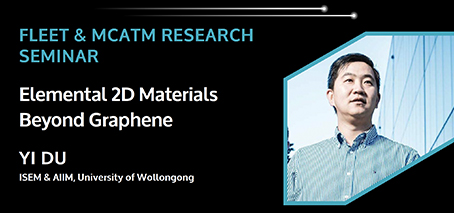-
27 Sep 2018
11:00 am - 12:00 pm
Elemental 2D Materials (Xenes) beyond Graphene
Yi Du
Institute for Superconducting and Electronic Materials, the Australian Institute for Innovative Materials, University of Wollongong
All welcome! The seminar flyer can be downloaded at this link.
About the Speaker:
Dr Yi Du obtained his B.Eng in Beihang University in 2004 and his PhD in University of Wollongong in 2011. He was awarded ARC Future Fellowship (FT2) in 2018. His research interests are in the research field of two-dimensional (2D) materials and surface physics and chemistry. His expertise covers molecular beam epitaxial (MBE) growth, scanning tunneling microscopy (STM), atomic force microscopy (AFM), angle-resolved photoemission spectroscopy (ARPES), ultra-high vacuum, electron beam lithography (EBL), and electronic structure design and engineering. His significant contributions to this field includes creation and revealing exotic properties of Xenes (silicene,germanene, and blue phosphorene). He has published more than 90 papers, including Sci. Adv., Nat. Commun., Adv. Mater., Phys. Rev. Lett., ACS Nano, and Adv. Funct. Mater. View his Research webpage.
Abstract:
Two-dimensional (2D) materials, which possess atomic or molecular thickness and infinite planar lengths, are regarded as a novel family of materials that have a great potential to transform modern electronics due to their unique nanostructures and electronic states, especially since the discovery of graphene, which possesses amazing functionalities such as high electron mobility and the quantum Hall effect at room temperature. Silicene and germanene, new allotropes of silicon and germanium in a 2D one-atom-thick honeycomb structure, could have the potential for promising applications in electronics, photonics, and the other related areas because they not only demonstrates essentially the same electronic properties as graphene, such as linear dispersion of the electron band and high Fermi velocity, but they also possess an energy gap at the Dirac point, stronger spin-orbital coupling (SOC) and inherent compatibility with the current semiconductor industry.
In this talk, I will review our recent work on silicene and germanene. By molecular beam epitaxial deposition, we successfully synthesized large-scale silicene and germanene layers on metallic substrates. The atomic honeycomb structures have been clearly demonstrated by scanning tunneling microscopy (STM). Their phonon properties and distinct electron-phonon coupling effects have been revealed by in–situ Raman spectroscopy. Dirac fermion characteristics of silicene and germanene were demonstrated by scanning tunneling spectroscopy (STS) and angle-revolved photoemission spectroscopy (ARPES). The electronic dispersion, band gap, Fermi velocity, and surface reactive sites at the nano scale and atomic scale on the surfaces of the silicene and germanene have been studied in details. We also successfully modulated their electronic properties by tuning interlayer interaction.
Venue: G30 New Horizons Centre, Monash University
Venue Website: https://www.monash.edu/engineering/our-research/facilities/new-horizons
Address:
